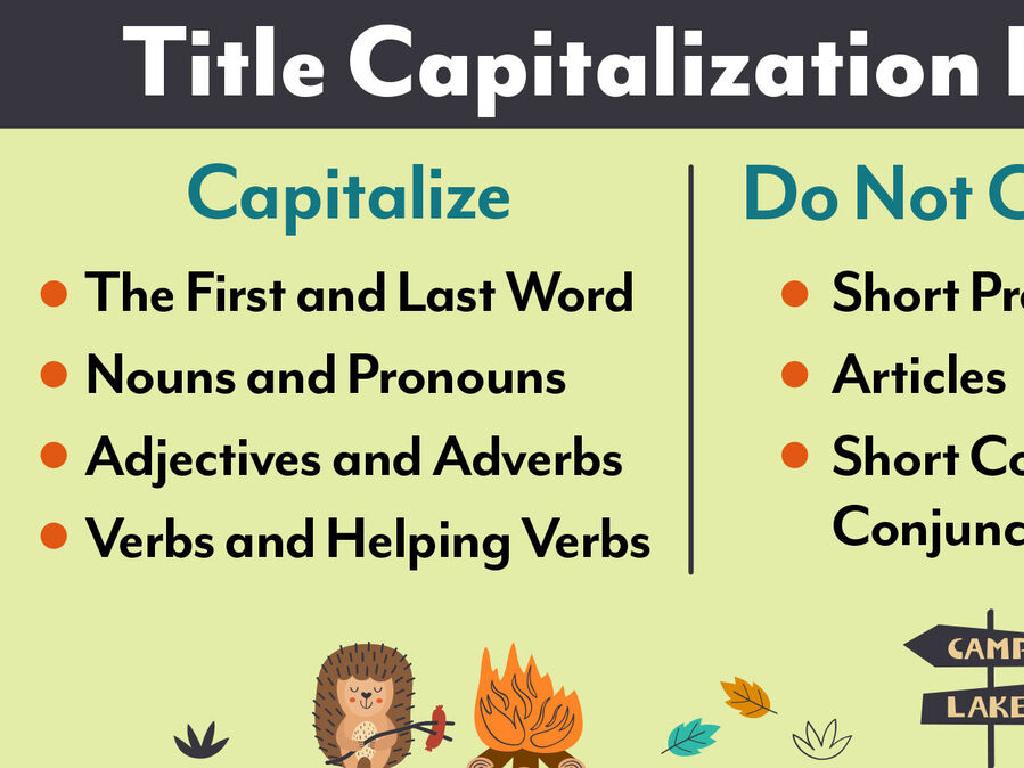Abbreviate People'S Titles
Subject: Language arts
Grade: Fifth grade
Topic: Abbreviations
Please LOG IN to download the presentation. Access is available to registered users only.
View More Content
Introduction to Abbreviations
– What are abbreviations?
– Shortened forms of words or phrases
– Reasons we use abbreviations
– To save time and space in writing
– Examples of common abbreviations
– e.g., Dr. for Doctor, Mr. for Mister
– Practice with title abbreviations
– Let’s abbreviate Mrs., Capt., and Prof.
|
Begin the lesson by explaining that abbreviations are shorter versions of words or phrases, which make writing and reading quicker and easier. Discuss the practicality of using abbreviations in everyday writing, such as taking notes or sending text messages. Provide familiar examples that the students encounter regularly, like ‘Dr.’ for Doctor or ‘Mr.’ for Mister. Engage the class by having them practice abbreviating titles such as Mrs. (Missus), Capt. (Captain), and Prof. (Professor). This will help them understand the concept and how it applies to real-world situations. Encourage students to think of other titles they know and how they might be abbreviated.
Understanding People’s Titles
– What are titles?
– Titles are words like Mr., Mrs., or Dr. that go before names.
– Importance of titles
– Titles show respect and professional status.
– Examples of titles
– Mr. for men, Mrs. for married women, Ms. for women, Dr. for doctors.
– Practice abbreviating titles
|
This slide introduces the concept of titles and their significance in daily communication. Titles are honorifics used to show respect and to address people properly. They can indicate marital status, gender, and professional or academic achievement. Provide examples like ‘Mr. Smith’ for men, ‘Mrs. Jones’ for married women, ‘Ms. Green’ for women in general, and ‘Dr. Brown’ for someone with a doctoral degree. After explaining, engage the students in an activity where they practice abbreviating titles for various scenarios, reinforcing their understanding of when and how to use them correctly.
Abbreviating People’s Titles
– How to abbreviate common titles
– Mr., Mrs., Dr. stand for Mister, Missus, Doctor
– When to use title abbreviations
– Use before full names, e.g., Dr. Smith
– Practice with title abbreviations
– Write sentences using Mr., Mrs., Dr.
– Rules for capitalization & periods
|
This slide introduces students to the concept of abbreviating titles such as ‘Mr.’, ‘Mrs.’, and ‘Dr.’. Explain that these are shorter forms of titles used before someone’s last name as a sign of respect. Discuss appropriate contexts for using these abbreviations, such as in formal writing or when addressing envelopes. Engage the class with practice exercises where they write sentences using these abbreviations correctly. Emphasize the importance of capitalization and using a period after each abbreviation. This will help students become familiar with common practices in writing and enhance their understanding of formal address.
Rules for Abbreviating Titles
– Always add a period after abbreviations
– E.g., ‘Dr.’ for Doctor, ‘Mr.’ for Mister
– Use capital letters for titles
– Titles like ‘Mr.’, ‘Mrs.’, ‘Dr.’ should be capitalized
– Abbreviate titles with names only
– ‘President’ alone is not abbreviated, but ‘President Lincoln’ becomes ‘Pres. Lincoln’
– Practice with common titles
– Try abbreviating ‘Doctor Smith’ and ‘Miss Jones’
|
This slide introduces students to the basic rules of abbreviating titles in written English. Emphasize the use of periods as a key part of abbreviations, which signals to the reader that a word has been shortened. Stress the importance of capitalization for respect and formality. Clarify that titles without a following name are not abbreviated to avoid confusion. Provide examples like ‘Mr. Smith’ and ‘Dr. Adams’ to illustrate proper abbreviation. Encourage students to practice by writing sentences using abbreviated titles and to be mindful of these rules in their daily writing.
Class Activity: Abbreviating Titles
– Write title abbreviations individually
– Pair up to compare answers
– Discuss the importance of abbreviations
– Why are abbreviations useful in writing?
– Reflect on what you’ve learned
|
This activity is designed to engage students with the practical application of abbreviating titles. Start by having each student write down the correct abbreviations for a list of titles you provide. Then, students will pair up to compare their answers and discuss any discrepancies. This peer interaction reinforces learning and allows students to teach each other. Afterward, lead a group discussion on the importance of abbreviations, such as saving space in writing and maintaining formality in certain contexts. Conclude with a reflection session where students can share what they’ve learned and how they might use abbreviations in their own writing. Possible titles for abbreviation practice include Mr., Mrs., Dr., and Prof.
Recap & Homework: Abbreviating Titles
– Review of title abbreviations
– Why correct title use matters
– Homework: 10 sentences
– Create sentences with Mr., Mrs., Dr., etc.
– Practice using abbreviations
– Helps reinforce today’s lesson
|
This slide concludes the lesson by summarizing the key points about abbreviating people’s titles. Emphasize the importance of using titles correctly as a sign of respect and in formal writing. For homework, students are tasked with writing ten sentences that incorporate abbreviated titles, such as ‘Mr.’, ‘Mrs.’, ‘Dr.’, etc. This exercise will help students practice and internalize the abbreviations covered in class. Encourage creativity and the use of a variety of titles. In the next class, ask students to share some of their sentences to check for understanding and to provide feedback.





